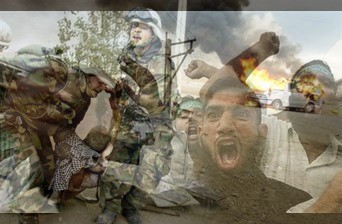Royal Marines attempt daring Apache rescue during Afghanistan Operation

This story is so incredible, I am publishing it in full. From defence news in Britain:
Marines attempt daring Apache rescue during Afghanistan Operation
17 Jan 07
Royal Marines carried out a dramatic rescue attempt of their comrade, Lance Corporal Mathew Ford, in Afghanistan on Monday 15 January 2007. It was with great sadness that they later discovered he had been killed in action.
Mortar Teams from 42 Commando Royal Marines fire 81mm mortars into known Taliban positions during Operation Glacier which was a deliberate action against the Taliban stronghold of Jugroom Fort, Garmsir, Afghanistan
Lance Corporal Ford, from 45 Commando Royal Marines, died when his UK Task Force attacked a major Taliban fort in southern Helmand Province. The attack began at dawn on Monday 15 January 2007, on the Taliban base of Jugroom Fort, south of Garmsir. Z Company 45 Commando, mounted in Vikings and supported by C Squadron, Light Dragoons, crossed the Helmand river to the south west of the fort. 3 Commando Brigade Reconnaissance Force (BRF), had already secured the crossing point. The marines then dismounted to engage the Taliban with small arms fire.
The attack was supported by elements of 29 Commando Regiment Royal Artillery, elements of 59 Independent Squadron Royal Engineers, elements of 32 Regiment Royal Artillery along with attack helicopters and aircraft. Earlier, I Company, alongside the Afghan National Police had conducted an attack further to the north of the fort.
The UKTF met ferocious Taliban fire from all sides. As planned, Z Company then withdrew back to the far side of the Helmand river having successfully completed their objective. The engagement lasted for approximately five hours.
It is believed a number of Taliban targets were killed but it is not possible to say how many.
Having fought for a period, the Marines regrouped. When they discovered Lance Corporal Ford was missing they flew back, strapped to Apaches, to find their fallen comrade in a unique rescue mission attempt.
An initial plan was hatched to use Viking vehicles but they eventually concluded that the Apache WAH-64 attack helicopters would provide a quicker and safer means to get him out and back to safety.
And so four troops were strapped to the small side 'wings' of two Apaches, two to each helicopter. A third Apache provided aerial cover, and further units laid down a mass of covering fire while the other two Apaches landed.
All four men got off, as well as some of the aircrew, to provide additional firepower and to assist with the recovery of Lance Corporal Ford.
UK Task Force spokesman Lieutenant Colonel Rory Bruce, said: "It was a leap into the unknown. This is believed to be the first time UK forces have ever tried this type of rescue mission.
 "It was an extraordinary tale of heroism and bravery of our airmen, soldiers and marines who were all prepared to put themselves back into the line of fire to rescue a fallen comrade."
"It was an extraordinary tale of heroism and bravery of our airmen, soldiers and marines who were all prepared to put themselves back into the line of fire to rescue a fallen comrade."Royal Marine Commando, Sergeant Jim Morrad provides cover for Corporal Aidy Callender of the Royal Marines Combat Camera Team (CCT) as he records incoming fire from 107mm rockets, fired by Taliban Insurgents into the District Centre of Garmsir
Explaining the rationale behind the initial attack on the fort, Lt Col Bruce added: "Our intention was to show the insurgents that they are not safe anywhere, that we are able to reach out to them and attack whenever and wherever we choose, even where they think they are at their safest. To that end, the mission was a success and the insurgents now know we can and will strike at any time.
"By conducting operations on this basis we do not allow the Taliban to regroup and rearm during the winter period. The attack reflects UKTF’s intent to restore confidence in the local population in the Garmsir area, to allow locals to improve their livelihoods without fear of persecution from Taliban.
"ISAF troops are keen to restore security around the deserted town of Garmsir so that the reconstruction effort can continue and Garmsir can once again thrive as the southern gateway to the Helmand development zone.
"Taliban forces have been present in the area for several months causing much of the local population to disperse. The operation sought to help provide a secure environment and reassure the population that they can begin to return to their homes. This will then allow ISAF to begin the process of reconstruction in the area."
Mortar Teams from 42 Commando Royal Marines take cover as Taliban insurgents fire 107mm rockets back in to the District Centre Compound, Garmsir during Operation Glacier
Lieutenant Colonel Rob MaGowan, who commanded the operation, said: "Tremendous bravery, professionalism and endurance was evident across the battlefield by all troops involved in the operation.
"This was a deliberate pre-planned operation to disrupt the insurgents freedom of movement in southern Helmand, a vital area for insurgents to equip and move fighters into the centre of the province."
During the battle, in addition to the fatality of Lance Corporal Ford, the UK Task Force sustained four casualties. All four casualties are in a stable condition.








No comments:
Post a Comment